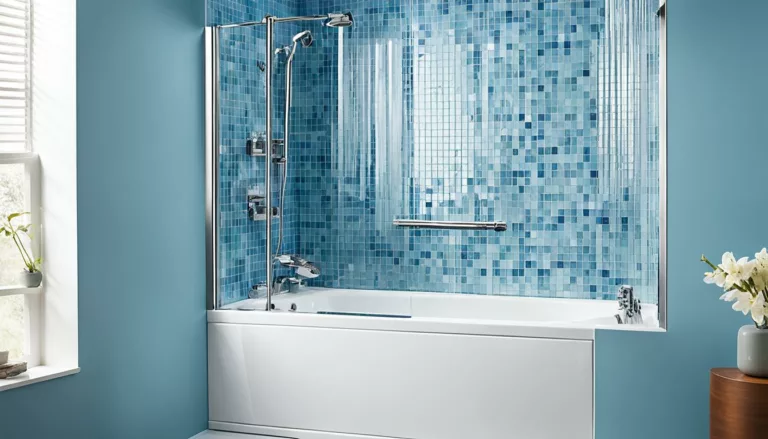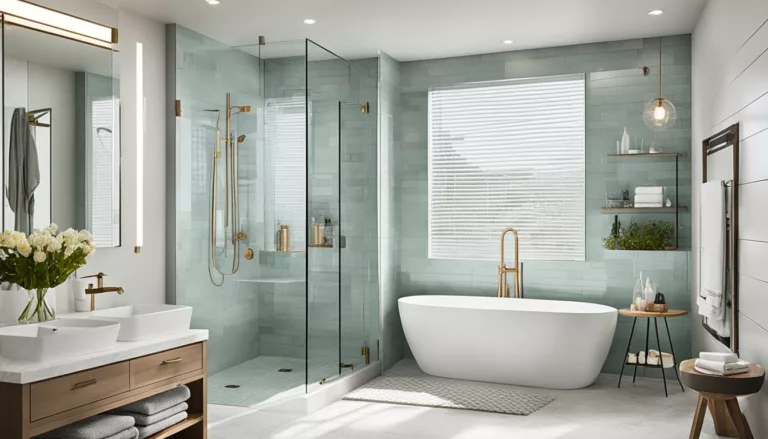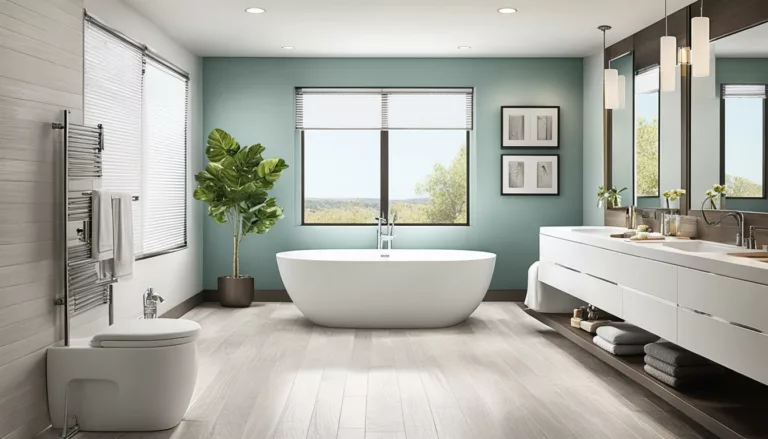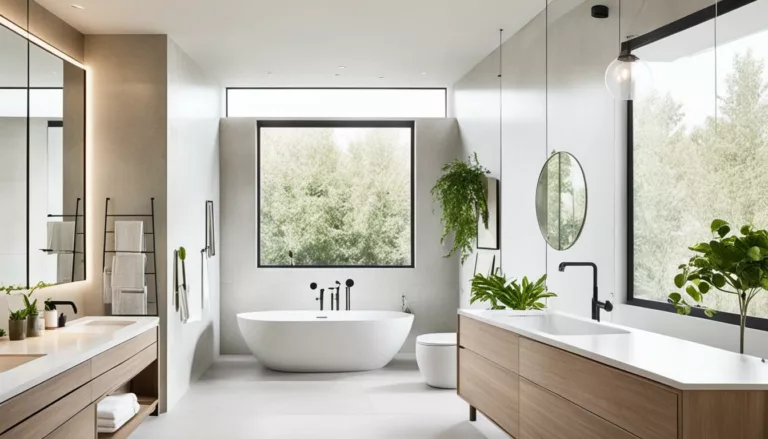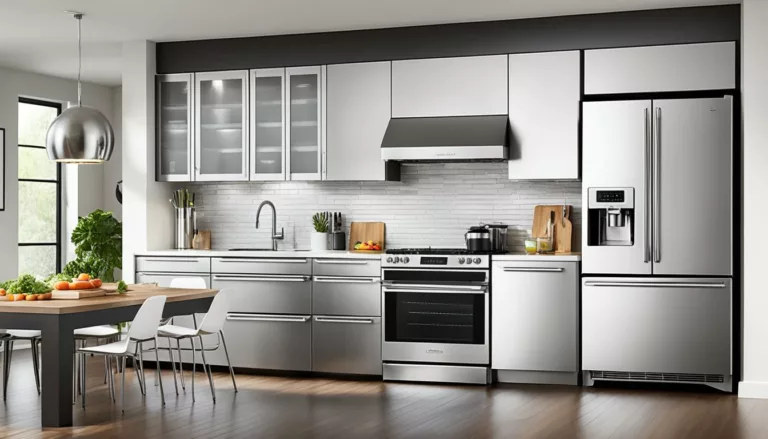Your kitchen is the heart of your home. It should be warm and inviting, reflecting your style. Lighting is key to making it functional, beautiful, and welcoming. This guide will give you the best lighting tips to make your kitchen a standout.
Key Takeaways
- Understand the importance of proper kitchen lighting for functionality and ambiance
- Explore the concept of layering lighting to create a balanced and versatile design
- Discover the benefits of different lighting types, including ambient, task, and accent lighting
- Learn about energy-efficient lighting solutions and their impact on your kitchen’s aesthetic and sustainability
- Gain insights into lighting placement and fixture selection for various kitchen layouts
The Importance of Proper Kitchen Lighting
Proper kitchen lighting is key to making your space both functional and welcoming. It boosts the look and feel of your kitchen. It also makes cooking safer. By picking the right lighting, you can make your kitchen both beautiful and useful.
Enhancing Functionality and Ambiance
Good kitchen lighting is a must for everyday tasks. Kitchen lighting helps with food prep, cooking, and cleaning. It makes sure you can work well and safely. Plus, it sets the mood, making your kitchen warm and inviting.
The right lighting design changes how your kitchen works and feels. It makes the space more functional and adds to the ambiance.
Safety Considerations
Keeping your kitchen safe is important, and lighting is a big part of that. Kitchen lighting prevents accidents by lighting up dangers like sharp edges and hot surfaces. It keeps your cooking area safe and comfy.
“Proper kitchen lighting is not just about illumination; it’s about creating a harmonious and functional space that enhances your everyday culinary experience.”
Layering Kitchen Lighting
Creating the perfect kitchen lighting means layering different types of lights. This approach ensures a balanced and cohesive look. By using task, ambient, and accent lighting, you get a lighting scheme that meets your needs and tastes.
Task lighting, like under-cabinet lights or pendant fixtures, is key for work areas. It makes sure you can work easily and efficiently. Ambient lighting, through recessed fixtures or flush-mounted lights, adds a warm glow to the space. Accent lighting highlights certain areas or features, adding depth and interest.
When layering kitchen lighting, finding the right balance is crucial. Mixing task, ambient, and accent lighting creates a lighting design that’s both functional and beautiful. This enhances your kitchen’s overall look and feel.
“Proper kitchen lighting is essential for both functionality and ambiance. By layering different lighting sources, you can create a space that is both aesthetically pleasing and highly practical.”
- Identify your key task areas and ensure they are well-lit with task lighting.
- Add ambient lighting throughout to make the space warm and welcoming.
- Use accent lighting to spotlight architectural features, artwork, or other design elements.
- Try dimmers and lighting controls to change the brightness and mood as you like.
By thoughtfully layering your kitchen lighting, you can turn your space into a beautifully lit and functional area. It’s perfect for cooking, entertaining, and everyday living.
Ambient Lighting for a Warm Glow
Ambient lighting is key to making your kitchen cozy and inviting. It gives off a warm, soft light that makes the space feel welcoming. By picking the right ambient kitchen lighting, you can make your kitchen a place where everyone feels at ease.
Recessed Lighting and Flush Mounts
Recessed lighting and flush mount lighting are great for a sleek look. They’re installed right into the ceiling, giving a smooth and even light. This type of lighting brightens the room without making the light fixtures stand out. It’s perfect for a soft, spread-out light in the kitchen.
Chandeliers and Pendant Lights
Chandeliers and pendant lights add elegance and interest to your kitchen. They can be the room’s centerpiece, pulling the eye up and adding a sense of luxury. The right chandeliers and pendant lights match your kitchen’s style, whether it’s classic or modern. They help create a warm, welcoming feel.
“Lighting is crucial in creating the right ambiance and setting the tone for the entire kitchen space.”
Task Lighting for Efficient Workspaces
In kitchen design, task lighting is key. It lights up specific areas like countertops, sinks, and cooking surfaces. This makes your kitchen work better and more efficient. Under-cabinet lighting is a great choice for task lighting.
Under-Cabinet Lighting
Under-cabinet lighting shines light on your work surface lighting. It helps with meal prep, chopping, and other tasks. This task kitchen lighting boosts your kitchen’s usability and comfort. It cuts down on eye strain and makes things clearer.
There are many styles and types of under-cabinet lighting, like LED strips and puck lights. You can pick one that fits your kitchen’s look. These lights are easy to put under your cabinets, giving your kitchen a clean look.
“Proper task lighting is essential for creating an efficient and user-friendly kitchen. Under-cabinet lighting takes your work surface illumination to the next level, making meal preparation a breeze.”
Think about where and how you want your task kitchen lighting to work. This ensures your kitchen is well-lit and great for working.
Accent Lighting to Create Focal Points
Making your kitchen look great is all about finding the right mix of lighting. Ambient and task lighting are key for everyday use. But accent kitchen lighting is what makes your space pop, highlighting special areas that catch the eye.
By placing accent lights smartly, you can focus attention on certain parts of your kitchen. This could be a stunning backsplash, detailed tile work, or eye-catching cabinetry. This way, your lighting design not only looks better but also makes your kitchen feel more alive.
Think about adding accent lights under cabinets, above shelves, or inside glass-front cabinets. These spots of light can turn ordinary areas into eye-catching highlights. They make your kitchen more interesting and engaging.
For great accent kitchen lighting, it’s important to get the balance right. You want your kitchen to feel welcoming but not too bright. Try different spots and levels of light to highlight your kitchen’s best features.
Kitchen Lighting Tips for Different Kitchen Layouts
The layout of your kitchen greatly affects the best lighting design. Whether your kitchen is a cozy galley kitchen or a big open-concept kitchen, knowing what lighting you need is key. It makes your kitchen both useful and nice to look at.
Lighting for Galley Kitchens
In a galley kitchen, where space is limited, smart lighting is a must. Use task lighting like under-cabinet lights or recessed lights for your work areas. This kind of lighting makes sure you can work well and brightens up the space.
Lighting for Open-Concept Kitchens
Open-concept kitchens blend well with the living area and need a full lighting plan. Mix ambient lighting from pendant lights or chandeliers with task lighting over counters and islands. Add accent lighting to show off special features or display areas. This mix makes sure the whole space is well-lit and looks good together.
No matter your kitchen’s layout, finding the right balance between useful and nice-looking lighting is important. By thinking about what your kitchen needs, you can make it a warm and welcoming place for cooking.
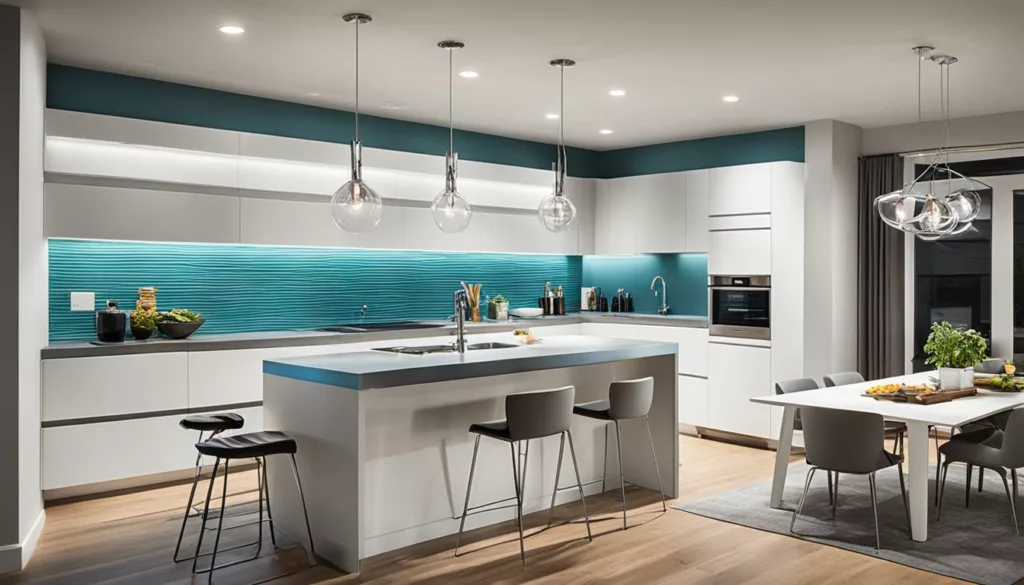
Energy-Efficient Lighting Solutions
Adding energy-efficient lighting to your kitchen can cut down on energy use and bills. It also helps make your home more eco-friendly. LED and CFL bulbs are two top choices for saving energy.
LED and CFL Bulbs
LED lighting is now a top pick for saving energy in kitchens. LEDs use much less energy than old-style bulbs and last much longer. They give off a bright, focused light ideal for tasks and fit many fixtures, like under-cabinet lights.
CFL bulbs are another smart choice for saving energy. They don’t last as long as LEDs but use less energy than old bulbs. CFLs give off a warm light that makes your kitchen feel welcoming. They’re also a budget-friendly option.
- LED bulbs use up to 80% less energy and last 25 times longer than incandescent bulbs
- CFL bulbs use 25-35% less energy than incandescent bulbs and provide a warm, inviting light
- Both LED and CFL options are excellent choices for energy-efficient kitchen lighting
Using energy-efficient kitchen lighting like LED lighting and CFL lighting makes your kitchen bright, useful, and green. It also saves you money on energy bills.
Lighting Controls and Dimmers
Upgrade your kitchen lighting with kitchen lighting controls and dimmers. These features change the look and feel of your space. They add versatility and make your life easier.
Dimmers let you change the light intensity easily. This is great for cooking, entertaining, or just enjoying a coffee. Dimmers give you control that makes your kitchen better.
Automated lighting automation takes things to the next level. With a button or voice command, adjust your lights and set scenes. These smart systems are stylish, save energy, and are good for the planet.
Choosing manual or automated lighting controls changes how you see your kitchen. With customizable lighting, your kitchen shows off your style and needs.
Kitchen Lighting Fixtures and Styles
Choosing the right kitchen lighting can change how your space looks. You can pick from traditional or modern styles to match your kitchen’s look and what you like.
Traditional Kitchen Lighting
If you like a classic look, traditional kitchen lighting is a great choice. Chandeliers and pendant lights add elegance and warmth. They come in many designs, from vintage to simple.
Modern Kitchen Lighting
For a sleek look, modern kitchen lighting is perfect. It includes recessed lights and linear pendants. These lights have clean lines and modern finishes, fitting well with a modern kitchen.
When picking kitchen lighting, think about both looks and function. This way, you get the best of traditional and modern lighting for your kitchen.
“The right kitchen lighting can transform the entire atmosphere of your space, enhancing both functionality and visual appeal.”
Professional Kitchen Lighting Design
Getting expert advice is key to a well-lit and functional kitchen. If you’re unsure about your kitchen lighting design, talk to a professional kitchen designer. They offer insights and guidance to create a lighting plan that fits your kitchen’s look and needs.
Investing in a kitchen design consultation is smart, especially for a kitchen remodel. Designers know the latest in lighting and can guide you. They help you pick lighting that looks good and works well in your kitchen.
Working with a pro means your kitchen will look great and work better. They ensure the lighting is right for tasks and mood. A skilled kitchen lighting designer meets your needs and likes.
“A well-designed kitchen lighting plan can transform the entire space and elevate the overall cooking and dining experience.” – Samantha, Interior Design Expert
Don’t wait to get help for your kitchen and bathroom remodel ideas. Experts can make your kitchen look amazing and work well. Call Prestige at (541) 852-9184 to set up your kitchen design consultation today.
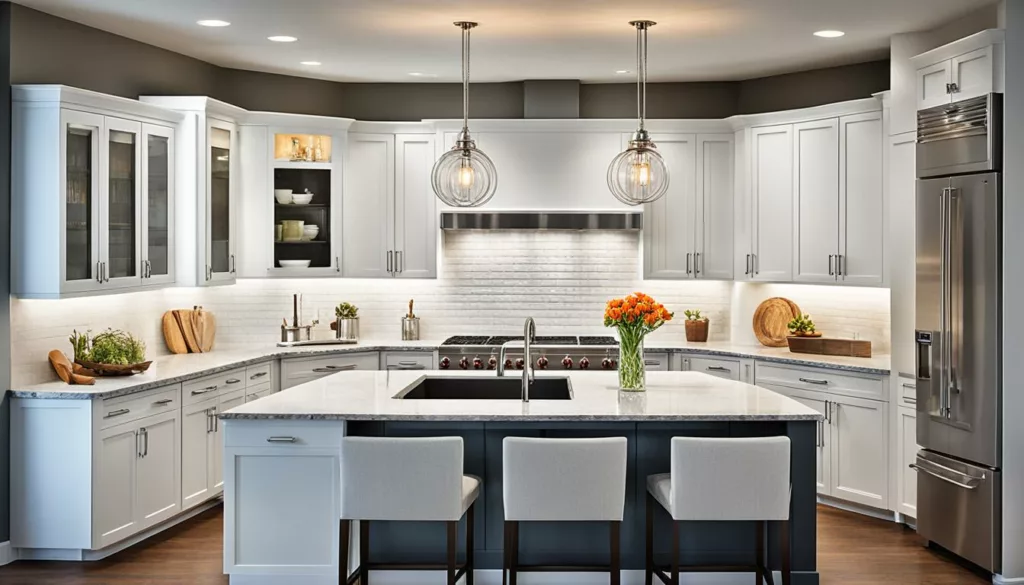
Conclusion
Using these key kitchen lighting tips, you can make your kitchen brighter and more functional. Think about layering lights, using energy-efficient options, and your kitchen’s layout. This will help you design the perfect lighting that suits your needs and boosts your home’s look.
Good kitchen lighting can change how your kitchen looks and works. By mixing ambient, task, and accent lighting, you can make your kitchen lively and welcoming. It will meet your everyday needs and match your style.
Let kitchen lighting change your cooking experience and turn your kitchen into a space that shows off your style. With the right lights, your kitchen will be efficient, cozy, and beautiful.
FAQ
What are the key elements of a well-designed kitchen lighting plan?
A well-designed kitchen lighting plan uses a layered approach. This includes task, ambient, and accent lighting. This mix makes your kitchen both functional and beautiful.
How can under-cabinet lighting improve my kitchen workspace?
Under-cabinet lighting is great for task lighting. It shines on your work surfaces. This makes cooking and cleaning easier and more comfortable.
What are the benefits of energy-efficient lighting options like LED and CFL bulbs?
LED and CFL bulbs save energy and cut down on utility bills. They last longer than old bulbs, giving you reliable lighting for years.
How can I use lighting controls and dimmers to enhance the versatility of my kitchen lighting?
Lighting controls and dimmers let you adjust your kitchen lights for different tasks. This makes your kitchen more functional and energy-efficient.
What are some considerations for lighting in different kitchen layouts?
Kitchen layout affects your lighting needs. Galley kitchens work well with task lighting and recessed fixtures. Open-concept kitchens need a mix of ambient, task, and accent lighting for balance.
How can I incorporate accent lighting to create focal points in my kitchen?
Use accent lighting to highlight kitchen features or add visual interest. Place lights to focus on details, artwork, or design elements. This adds depth and beauty to your kitchen.
When should I consider consulting a professional for my kitchen lighting design?
If you’re unsure about kitchen lighting, consider a professional. They offer insights and guidance. This ensures your lighting fits your kitchen design perfectly.

